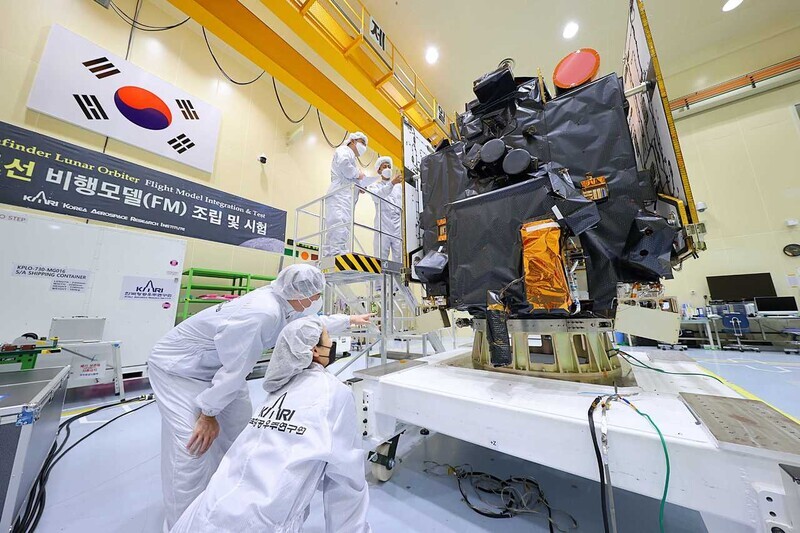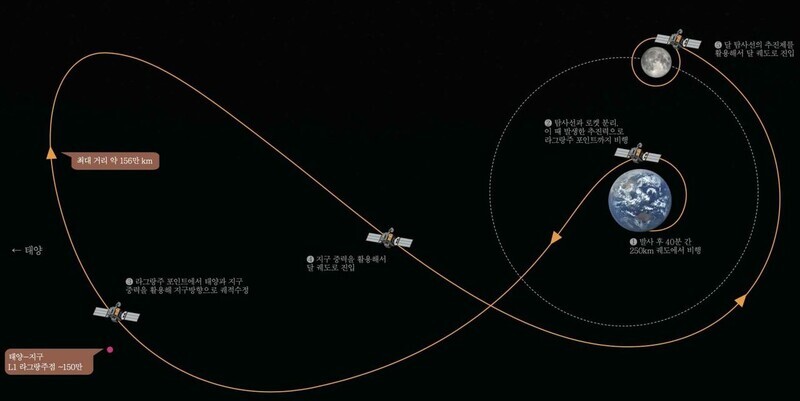hankyoreh
Links to other country sites 다른 나라 사이트 링크
Why S. Korea’s first lunar orbiter will take 4 months for a trip Apollo 11 did in 3 days

Danuri, South Korea’s first lunar probe, was unveiled to the press last Friday after the completion of pre-transportation procedures.
After being loaded into a specially produced container and relocated to Cape Canaveral Space Force Station in Florida on July 5, Danuri is to be launched into space at 8:20 am on Aug. 3. Four and a half months later on Dec. 31, it is scheduled to reach an orbit at an altitude of 100 kilometers above the lunar surface, where it will use its six payloads to perform scientific research over the following year.
In the following Q&A, the Hankyoreh shares some facts about South Korea’s first lunar probe.
Q: When Apollo 11 landed on the moon over 50 years ago, it took it three days to arrive there. In contrast, Danuri is taking over four months to reach lunar orbit. Why is it taking so much longer?A: There are three main routes for reaching the moon. There’s a direct transfer trajectory that goes straight there, there’s a phasing loop transfer trajectory that involves reaching lunar orbit by orbiting the Earth and gradually increasing altitude, and there’s what’s known as “BLT” (ballistic lunar transfer trajectory).
The approach adopted with Danuri is the third of these: the BLT trajectory. It’s a trajectory that minimizes energy requirements by taking advantage of the gravity of celestial objects such as the Earth and sun. In effect, it operates by way of those objects’ attractive force.
The plan is for Danuri to orbit by means of the Earth’s gravity until it overshoots lunar orbit, traveling as far as 1.56 million kilometers (969,339 miles) before returning to orbit around the moon. You can imagine it as wrapping around like a ribbon.
That’s why it takes four-and-a-half months. It takes as much as two months longer in travel time combined with the direct transfer and phasing loop transfer trajectories, but it potentially saves around 25% in fuel consumption.

A: Originally, the plan was to use a phasing loop transfer trajectory, which is quite common. But NASA in the US asked if Danuri could be loaded with a ShadowCam.
These cameras are on the heavy side. Including a ShadowCam altered the total weight from 550 kilograms to 678 kilograms (1,495 pounds). This was the reason behind the decision to go with the longer journey. Hopefully, the ShadowCam will allow for photography of the permanently shadowed portions of the moon that we’ve been unable to see because the sun’s light doesn’t reach them.
Q: Isn’t it unfair to have to take such a long route because of the US equipment?A: Not necessarily. NASA is providing South Korea with satellite data for communication with Danuri. Not only that, but the ShadowCam has the potential to make some significant scientific discoveries.
When Danuri was shown to the press on June 3, an official with the Korea Aerospace Research Institute (KARI) explained that collaboration was the “best way to resolve the technology gap between South Korea and more advanced countries,” and that cooperation with NASA would be an “opportunity to expand into deep space exploration.”
In this case, “deep space” refers to the more distant space beyond the moon. This is the farthest South Korea has ever ventured into space.
Q: What sort of launch vehicle is being used?A: Danuri is leaving for space on board a Falcon 9 rocket built by SpaceX, Elon Musk’s private space transportation corporation. The Falcon 9s are famous for being reusable. The rocket has already returned from five satellite launches, and the Danuri launch would be its sixth mission. It can reportedly be used around 15 times, so it is still a long way from being worn out.
Q: There have been reports that the probe will be carrying a song by BTS.A: That has not been decided yet. The plan was shared in a Q&A with the press in April, but as the presiding institution, the Electronics and Telecommunications Research Institute would need to hold discussions with BTS’ agency on permission and rights to the music.
The reason for carrying the music is to research “space internet” services. Danuri will be carrying a DTN space internet payload to conduct experiments on transmitting music to Earth from space.

A: The responsibilities are being carried out by KARI’s mission management center. Sixty people will be working on it, including backup staff. They’re in charge of operating Danuri in terms of things like trajectory correction and entry maneuvers.
Q: It’s been over half a century since the US Apollo 11 mission landed humans on the moon. Why is Korea getting started with lunar exploration now?
A: If Korea succeeds this time, it will be the seventh country to reach the moon.
Recently, not only the US but also China, India and Japan have been focusing their energy on exploring the moon. China has been intent on exploring the moon since 2013, when it joined the US and the former Soviet Union in successfully completing a moon landing. Meanwhile, the US has been working on Artemis, a lunar exploration project on a massive scale.
The first reason for exploring the moon has to do with the resources there, which include helium-3 and uranium. The second is because lunar exploration is seen as a stepping stone toward deep space exploration. If you want to reach Mars, you should first be able to travel easily to the moon and back.
Q: What happens to Danuri after it completes its mission?A: After reaching lunar orbit, Danuri will remain there at an altitude of 100 kilometers performing scientific missions with its six payloads. It is expected to take around two hours for it to orbit the moon once. (It will not actually be landing on the lunar surface.)
So it will be performing missions for a year, orbiting the moon around 12 times a day, and it could be used to perform even more missions as long as it does not run out of fuel.
By Nam Jong-young, staff reporter
Please direct questions or comments to [english@hani.co.kr]

Editorial・opinion
![[Column] Has Korea, too, crossed the Rubicon on China? [Column] Has Korea, too, crossed the Rubicon on China?](https://flexible.img.hani.co.kr/flexible/normal/500/300/imgdb/original/2024/0419/9317135153409185.jpg) [Column] Has Korea, too, crossed the Rubicon on China?
[Column] Has Korea, too, crossed the Rubicon on China?![[Correspondent’s column] In Japan’s alliance with US, echoes of its past alliances with UK [Correspondent’s column] In Japan’s alliance with US, echoes of its past alliances with UK](https://flexible.img.hani.co.kr/flexible/normal/500/300/imgdb/original/2024/0419/2317135166563519.jpg) [Correspondent’s column] In Japan’s alliance with US, echoes of its past alliances with UK
[Correspondent’s column] In Japan’s alliance with US, echoes of its past alliances with UK- [Editorial] Does Yoon think the Korean public is wrong?
- [Editorial] As it bolsters its alliance with US, Japan must be accountable for past
- [Guest essay] Amending the Constitution is Yoon’s key to leaving office in public’s good graces
- [Editorial] 10 years on, lessons of Sewol tragedy must never be forgotten
- [Column] A death blow to Korea’s prosecutor politics
- [Correspondent’s column] The US and the end of Japanese pacifism
- [Guest essay] How Korea turned its trainee doctors into monsters
- [Guest essay] As someone who helped forge Seoul-Moscow ties, their status today troubles me
Most viewed articles
- 1[Column] The clock is ticking for Korea’s first lady
- 2Samsung barricades office as unionized workers strike for better conditions
- 3[Editorial] When the choice is kids or career, Korea will never overcome birth rate woes
- 4S. Korea, Japan reaffirm commitment to strengthening trilateral ties with US
- 5[News analysis] After elections, prosecutorial reform will likely make legislative agenda
- 6Japan officially says compensation of Korean forced laborers isn’t its responsibility
- 7[Editorial] As it bolsters its alliance with US, Japan must be accountable for past
- 8[Editorial] Does Yoon think the Korean public is wrong?
- 9Why Israel isn’t hitting Iran with immediate retaliation
- 10[Interview] Learning about the Sewol tragedy through BTS